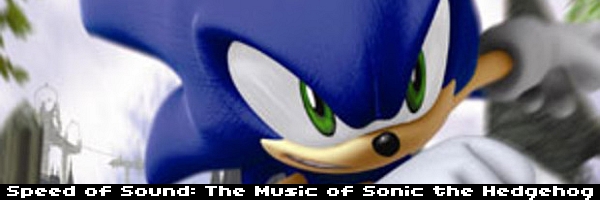
Let’s pretend the year is roughly 2000. It’s Sonic’s tenth anniversary. It’s his first real debut into the third dimension. The game is Sonic Adventure. It will be heralded as a general success. It will set some major tropes for the future of the 3D series to come, though it’s a bit of an oddity. At worst, it will later be looked back upon as “good for its time.” You advance through the levels – suddenly you’re on Speed Highway. The dark of a city forever trapped in the night – highways impossibly bent and stretched along the sides of buildings, through the air. Clear signs of construction that is, considering the landscape, entirely unfinished. This, gamer, is your music.
It’s a representation of the “new Sonic” that this game establishes. This is the musical language that will come to represent him. This is his carefree personality delivered in musical form. The music is rock influenced. Sonic has been introduced to, through the wonders of modern technology, the electric guitar.
Fast forward ten years later. It’s Sonic’s 20th anniversary. He’s seen better days. He’s had some less-than-stellar releases. He’s gone through no fewer than three attempts at “rebooting” his franchise. So, in a great bit of fanservice – in an attempt to assuage the rage of the Sonic-loving populace – Sega reintroduces “Classic” Sonic. The game: Sonic Generations. In the title, the “modern,” post-Sega-Genesis Sonic the Hedgehog is placed side-by-side with his younger, portlier self. The game is split into two distinct halves: the shorter, “Classic” Sonic has gameplay reminiscent of the first Sonic games from the Sega Genesis. The taller, talkative, “Modern” Sonic plays his levels in the fast paced, speed-oriented style first introduced in Sonic Unleashed.
Furthermore, the entire game could be considered a remix. Both Sonics travel through levels and fight bosses from the past. Levels that first appeared on the Sega Genesis are remastered into glorious high-definition 3D. Modern Sonic journeys through locales that he never could have, and Classic Sonic is introduced to the levels that he’ll visit in his future. And so, both Sonics return to the Speed Highway.
Musically speaking, each Sonic has his own distinct personality. The music that appeared in Classic Sonic’s games was as limited as the Sega Genesis was. The sound was synthesized; the synthesizer was the Sega Genesis itself. Every instrument, every line, and every sample was touched by its electronic roots – it had a certain dark grittiness to it. Modern Sonic is a reborn Sonic. His music – the music that characterizes the levels he races through and the music that eventually becomes his theme song – is technologically advanced. His theme song features fully produced, recorded vocals. The themes of his levels feature live drums and electric guitar. So, of course, when he returns to Speed Highway, the music that accompanies him is something very close to the original – full of the rock vibe, the guitars, and the drums. The Classic version of that theme, however, is very interesting. We’re presented with this:
What, one has to ask, does this Euro-club-esque mix of Speed Highway have to do with the level, the game, and the character in general? We hear the sound of a sampled, Genesis-generated snare drum, an allusion to a rhythm native to classic Sonic. We avoid the recorded drums, guitars, and live instruments as much as we can and embrace the sounds of synthesis. Yet that isn’t it – there’s one more element that makes Classic Sonic who he is. One more thing that characterizes every iteration of Sonic and, hopefully, nearly game in existence. That something is the spirit of fun.
As a composer myself, I can’t help but think that the writer of this track was having a good time with it. The classic Speed Highway mix defied my expectations – there was no allusion to the coming wave of dance music in the track’s introduction. Or, more appropriately, I had no idea what was coming before the “drop” – the entrance of the bass drum and the track’s basic “groove.” That little musical trick is full of playfulness – plus there’s the fact that dancing itself is, hypothetically, fun. There’s more that can be taken from this, too. Times have changed. Even the old is affected by the new. Not even Classic Sonic could keep these new forms of music from invading his musical personality – his levels feature beautifully rendered 3D environments. He’s embraced modern innovations. Yet, he’s still staying true to his roots. The sounds used in this composition are almost entirely electronic – keeping with the spirit of the Sega Genesis and the spirit of synthesis itself. The effect of that track – and the rest of Classic Sonic’s excellent remixes – is incredibly poignant. It’s as if the sound of Sonic and Sonic himself have both grown throughout the generations. Here’s to more of the same.







